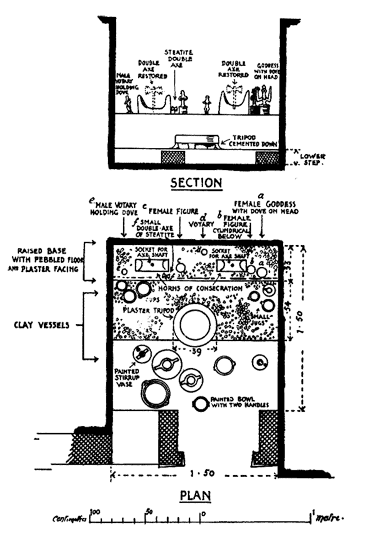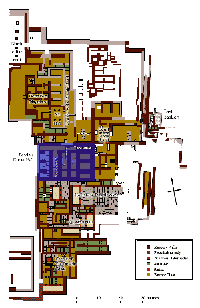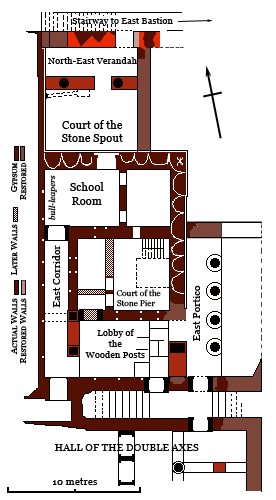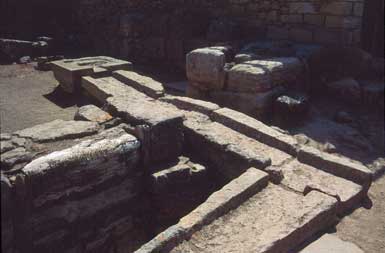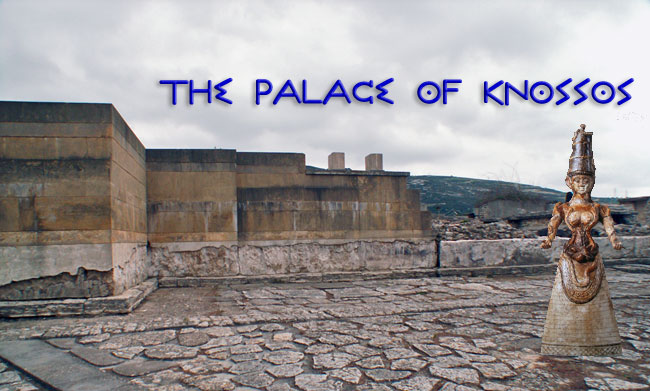
The East Wing
Shrine of the Double Axes
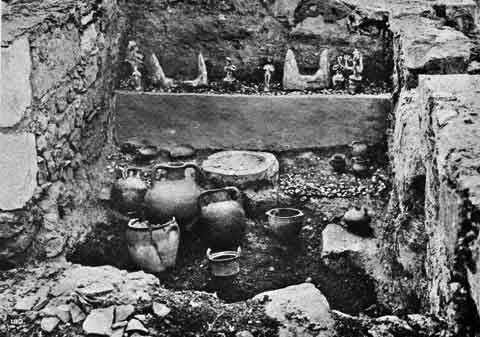
Excavation of the Shrine of the Double Axes
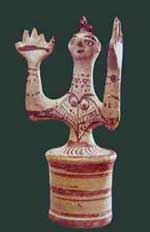 The southern part of the East Wing is an area of small rooms and corridors that appears to have been religious in character. There are storerooms and magazines, lustral basins and light-wells. Fragments of painted plaster and pieces of stucco relief suggest that there was an important hall or set of rooms upstairs but the only actual cult room that Evans found is the Shrine of the Double Axes.
The southern part of the East Wing is an area of small rooms and corridors that appears to have been religious in character. There are storerooms and magazines, lustral basins and light-wells. Fragments of painted plaster and pieces of stucco relief suggest that there was an important hall or set of rooms upstairs but the only actual cult room that Evans found is the Shrine of the Double Axes.
The room is tiny, barely a metre-and-a-half square, with a plastered clay bench at the back. It was installed, according to Evans, by squatters who reoccupied the site of the palace shortly after its final destruction. On the bench was a pair of sacred horns with sockets to hold small bronze double-axes. Around them were a number of terracotta figurines—a goddess with upraised arms, a pair of priestesses cupping their breasts and a pair of male votaries. In front of the bench was a raised area, paved with water-worn pebbles, a tripod altar and a collection of LMIIIb vessels.
Industrial Quarter
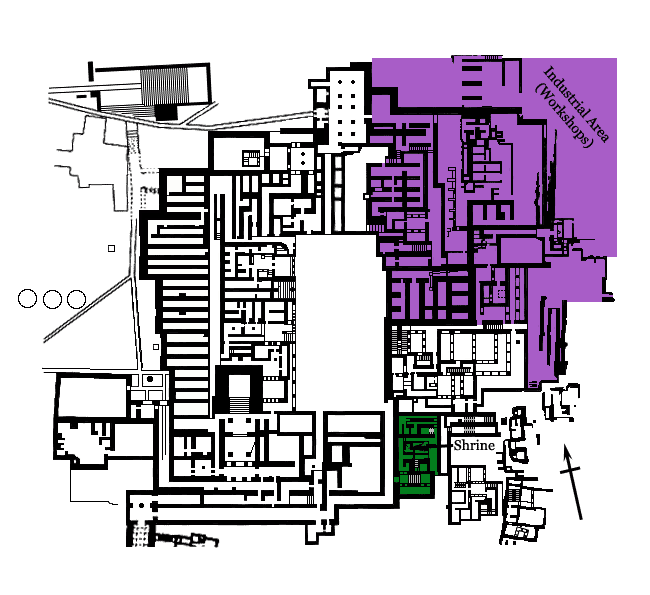
The area to the north of the Domestic Quarter was dedicated to storage facilities and small workshops—in the lower levels, at least. A doorway near the east end of the East-West Corridor led into a suite of that included a cellar room where the filled 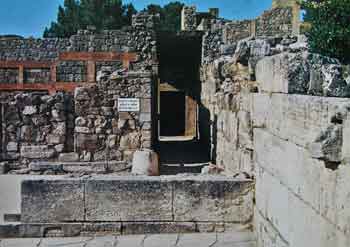 contained a cache of flecked green porphyry known as lapis Lacedaemonius along with a couple of unfinished amphorae made out of the same material. The stone had clearly fallen from the level above when the floor collapsed so Evans concluded that there must have been Lapidary’s Workshop upstairs.
contained a cache of flecked green porphyry known as lapis Lacedaemonius along with a couple of unfinished amphorae made out of the same material. The stone had clearly fallen from the level above when the floor collapsed so Evans concluded that there must have been Lapidary’s Workshop upstairs.
Beyond to the room with the lapis is another with a bench in one corner. Evans thought it was a school room but it was more probably a Potters Workshop. At the northern end of the suite was a small open area known as the Court of the Stone Spout (right) because of a drain outlet that projected into the court from high up the east wall. It was in the adjacent ‘School Room’ that the pieces of the famous Bull-leaping Frescoes were found, having evidently fallen from a room in the next storey. Bits of a number of similar scenes were found but this is the most complete. Along the side of this block of rooms is the East Portico, a four columned verandah overlooking the valley of the Kairatos.
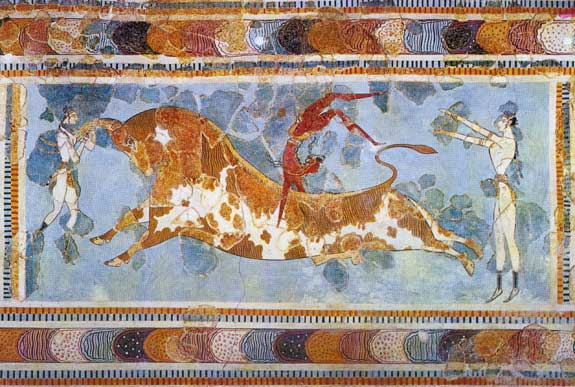
Evans’ Reconstruction of the Bull-Leaping Fresco
The north end of the Court of the Stone Spout opened onto a passageway that led to the edge of the terrace. No treads were found but presumably it was a stairway. The terrace wall, which shows evidence of several rebuildings, was severely damaged by the earthquake that finally destroyed Knossos. However, Evans uncovered a large block of masonry, which he called the East Bastion, at the end of the aforementioned passageway. The bastion included a postern and a set of steps that, after a number of turns, led to the bottom of the terrace and out to the 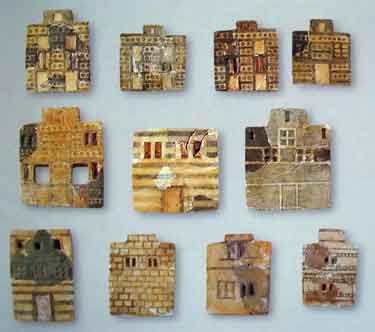 meadows beyond. It was in this low-lying ground between the palace and the Kairatos River that Evans envisioned as the arena for the bull-games. Most scholars, however, see the ‘bastion’ as simply the service entrance for all of the nearby workshops.
meadows beyond. It was in this low-lying ground between the palace and the Kairatos River that Evans envisioned as the arena for the bull-games. Most scholars, however, see the ‘bastion’ as simply the service entrance for all of the nearby workshops.
Next to the Central Court is a rectangular block of basement rooms including magazines equipped with large storage jars and smaller rooms with cult vessels and kitchen ware. Several of the rooms contained loom weights that had fallen from the floor above, indicating that weaving took place there. Fragments of painted plaster and stucco reliefs together with a pair of column bases suggest that a large hall of considerable importance (Evans called it the East Hall) occupied one of the upper storeys—perhaps the one level with the Central Court. In the fill on the northern edge of the block a number of faience plaques were found, part of a panel (or group of panels) known as the Town Mosaic (above left). Originally, they probably decorated a wooden box or chest but that has long since disintegrated. The pieces include fragments of landscapes, animals, marching soldiers and the prow of a ship but most notable are 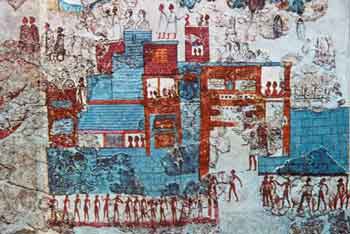 the towers and houses of a seaside town. The buildings are very carefully rendered and show many details of construction that proved very useful to Evans in his reconstruction of the palace. He thought the complete composition was a siege scene, similar to the one that appears on a silver vessel from Mycenae. A remarkably similar version of a complete scene was found painted on the walls of a house at Akrotiri on the island of Thera (right).
the towers and houses of a seaside town. The buildings are very carefully rendered and show many details of construction that proved very useful to Evans in his reconstruction of the palace. He thought the complete composition was a siege scene, similar to the one that appears on a silver vessel from Mycenae. A remarkably similar version of a complete scene was found painted on the walls of a house at Akrotiri on the island of Thera (right).
Running north is the Passage of the Draught Board (Evans found a game board made of crystal, faience and ivory along with gaming pieces) which runs past a room with a rather well preserved drainage system. A downspout brought rainwater to a long stone conduit which led to the outlet on the wall of the Court of the Stone Spout. The corridor continues past the North-East Hall and North-East Magazines and, after a couple of turns, ends up at the east side of the North Pillar Hall.
Unless otherwise stated, all black & white photos of Knossos are from The Palace of Minos by Arthur Evans and are reproduced here courtesy of the Ashmolean Museum, Oxford University

